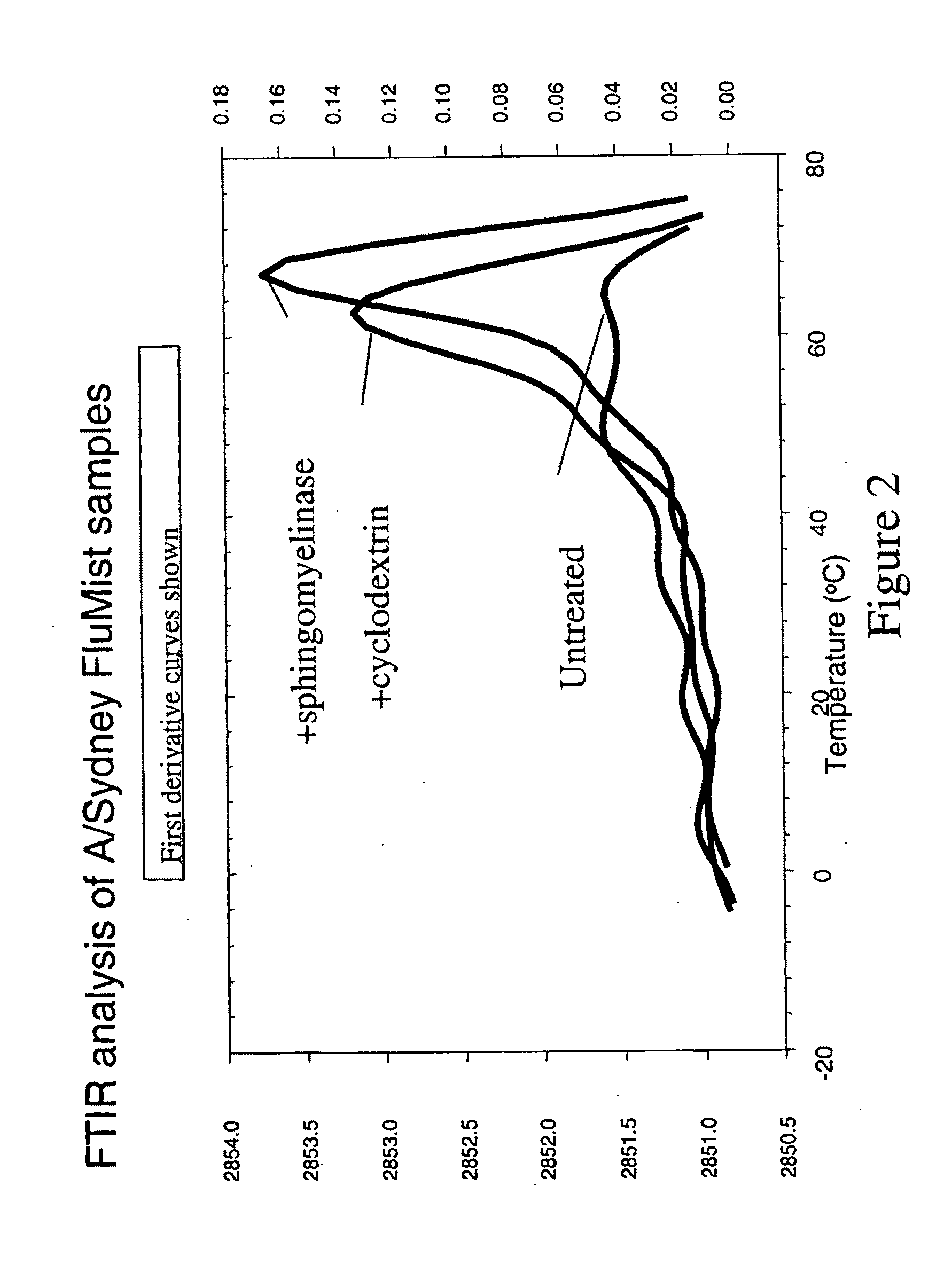Influencing viral lipid constituents
a technology of lipid constituents and viral cells, applied in the field of lipid constituents of viral cells and media, can solve the problems of significant alterations in the composition of normal membrane lipids, not necessarily uniform distribution, and significant drop in infectivity, so as to increase the yield of virus from the cell, increase the stability of virus in storage, and modulate the permissibility
- Summary
- Abstract
- Description
- Claims
- Application Information
AI Technical Summary
Benefits of technology
Problems solved by technology
Method used
Image
Examples
example 1
FTIR Microscopy of Membrane Phase Transitions
[0067]As shown in FIGS. 1A to 1C, lipid mobility of membranes was influenced by the cholesterol and sphingomyelin content of the membranes. The FTIR detected symmetric —CH2 stretching vibrations at ˜2850 cm−1, and to monitor vibrations of fatty acyl side chains of phospholipid tail groups. Wave number vs. temperature was plotted to identify membrane phase changes. Fluid phase high lipid mobility phase changes to gel-crystalline phase changes was detectable. Transition to higher wave numbers were found to indicate a higher order (or more rigid) membrane lipid environment.
[0068]The hydrophobic pocket of cyclodexrins has the ability to sequester cholesterol from membranes. When membrane cholesterol content was reduced by cyclodextrin treatment, as compared to the control of FIG. 1A, lipid mobility was reduced and the lipids found more ordered, as shown in FIG. 1B. As shown in FIG. 1C, the membrane melting point and lipid order was further in...
example 2
FTIR Analysis of Treated Virion Membranes
[0070]The order and lipid mobility of virus membranes were also found to be affected by changes in the lipid content. For example, as shown in FIG. 2, modification of the cholesterol content of the virus membrane (e.g., by cyclodextrin treatment) can change the mobility and phase transition characteristics. Moreover, conversion of membrane sphingomyelin to ceramide can also change the character of the membrane, as detected by FTIR. These experiments show that, as with permissive host cells, the virus has a relatively large amount of cholesterol and sphingomyelin. Virus membranes are shown to be enriched with cholesterol and sphingomyelin, even over the membranes of their most permissive host cells.
[0071]In one aspect, it is envisioned that FTIR analyses can be used to detect changes in a virus, e.g., with storage. For example, degradation or depletion of certain membrane lipid components can be correlated to changes in the FTIR profile.
[0072]...
example 3
Membrane Compositional Analysis Including Lipid Subtypes
[0073]Thin layer chromatography (TLC) and gas chromatographic methods were used to identify membrane lipids of 10 classes and 40 subclasses. The classes included; phosphatidylcholines, phosphatidylethanolamines, phosphatidylserine / inositols, sphingomyelins, cholesterol esters, free fatty acids, diacylglycerides, triacylglycerides, cardiolipins and lysophosphatidylcholines. Within the classes, the lipids were further characterized according to, e.g., what fatty acids are esterified to the lipid structure. The detection limit was typically about 1 nMole, and the assay variability was in the range of less than 10% run to run.
[0074]As shown in FIG. 3, among other things, the virus envelope membranes are enriched with sphingomyelin and glycolipids (phosphatidylserine / inositol), as compared to the host CAS cell membrane.
[0075]As shown in FIGS. 4 and 5, significant differences appear in lipid content subtypes between the host cell and...
PUM
| Property | Measurement | Unit |
|---|---|---|
| mole percentage | aaaaa | aaaaa |
| temperatures | aaaaa | aaaaa |
| phase transition temperature | aaaaa | aaaaa |
Abstract
Description
Claims
Application Information
 Login to View More
Login to View More - R&D
- Intellectual Property
- Life Sciences
- Materials
- Tech Scout
- Unparalleled Data Quality
- Higher Quality Content
- 60% Fewer Hallucinations
Browse by: Latest US Patents, China's latest patents, Technical Efficacy Thesaurus, Application Domain, Technology Topic, Popular Technical Reports.
© 2025 PatSnap. All rights reserved.Legal|Privacy policy|Modern Slavery Act Transparency Statement|Sitemap|About US| Contact US: help@patsnap.com



